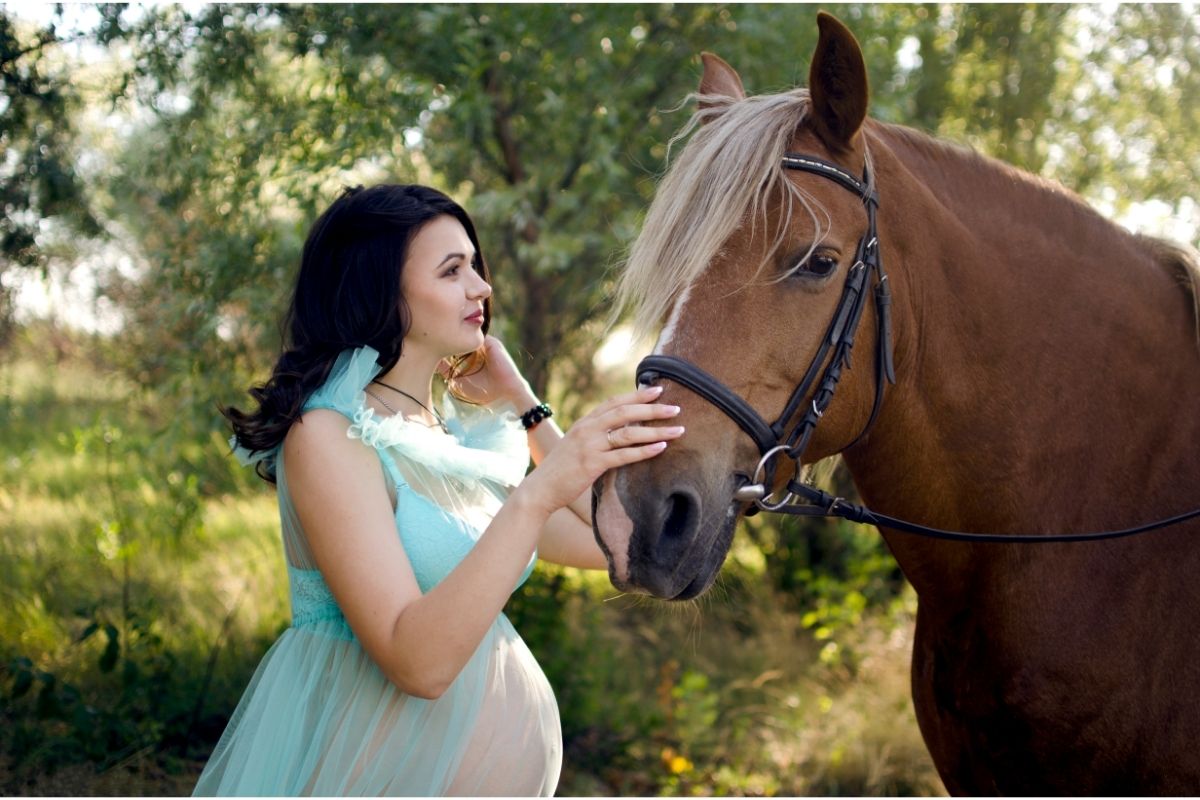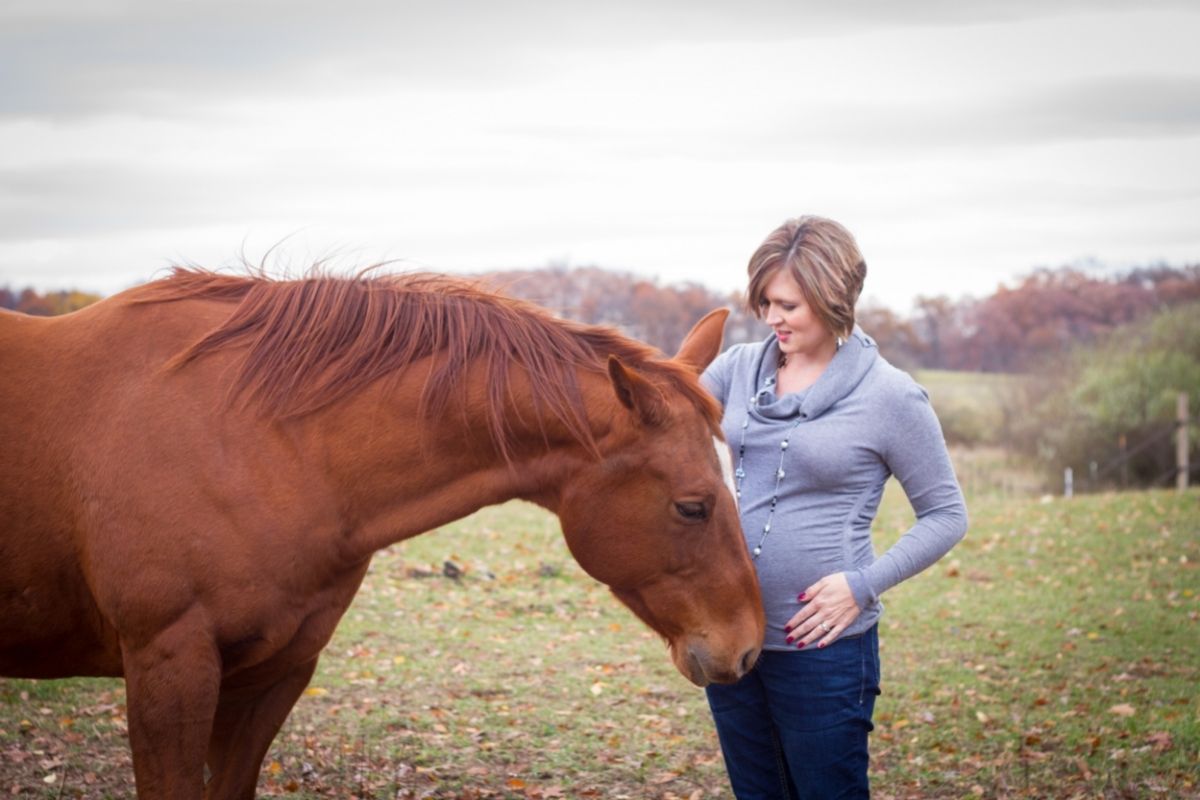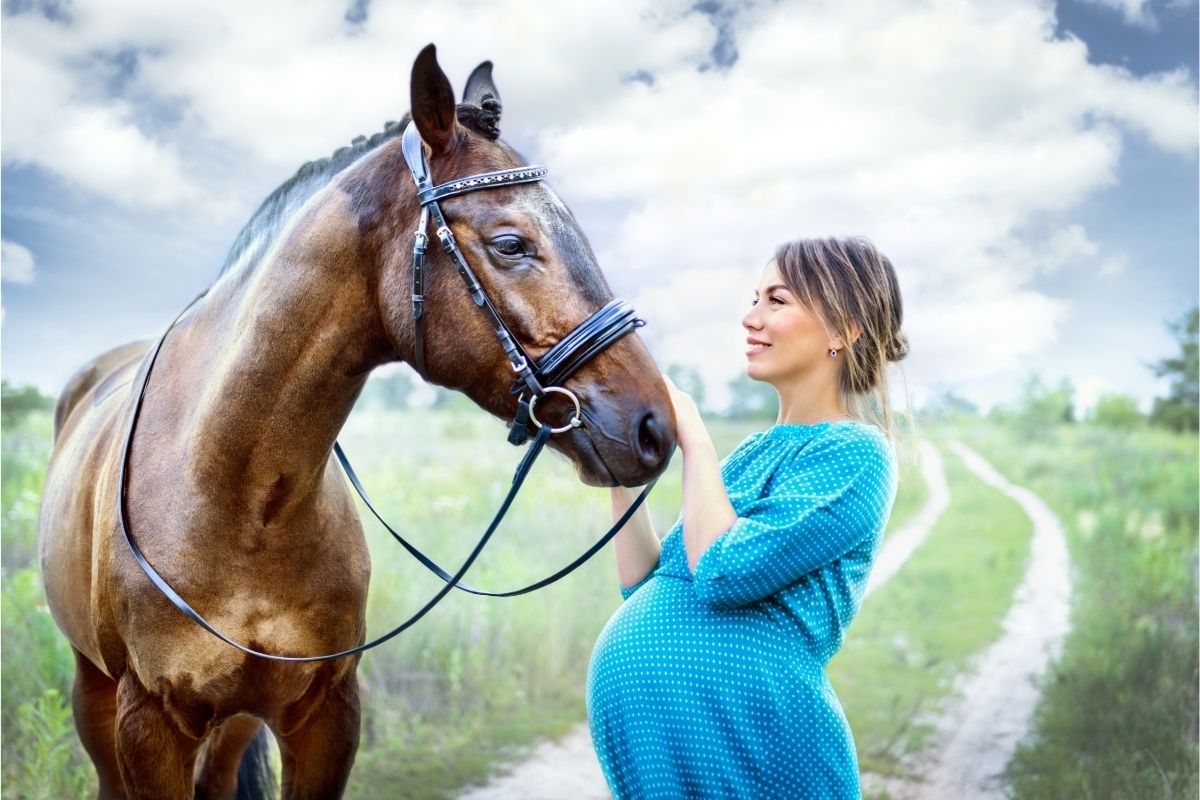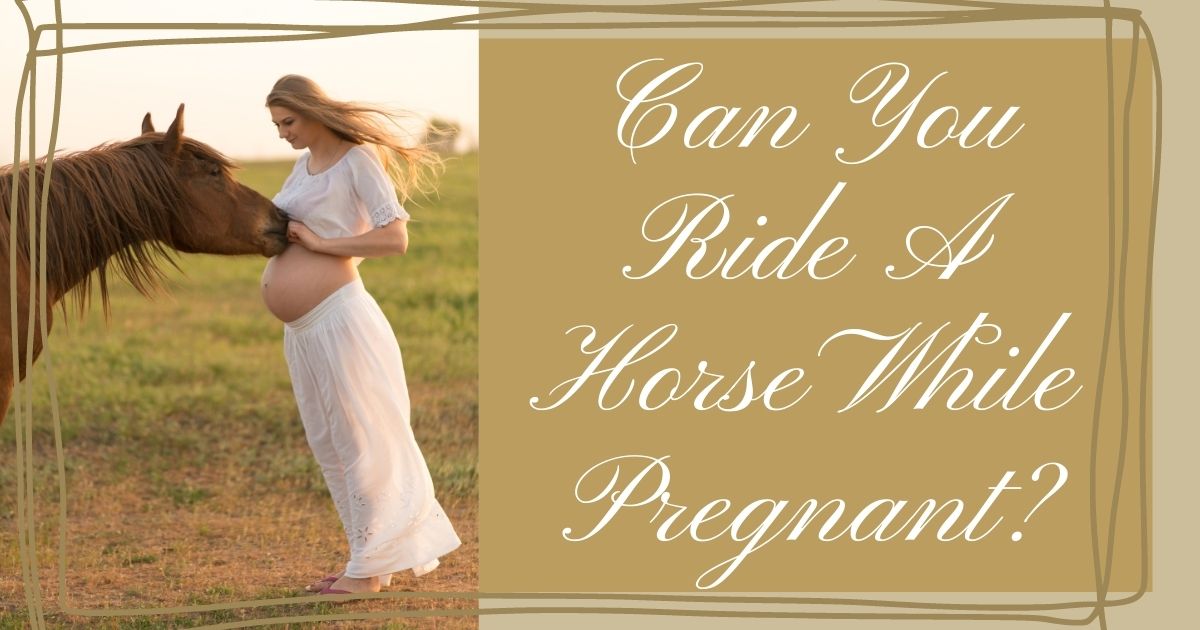Horseback Riding and Pregnancy
Different opinions emerge on this much-debated question; can you ride a horse while pregnant? Whether it is safe for a pregnant woman to ride a horse is a matter of debate. Each woman’s health, riding abilities, and riding opportunities are unique.
However, before we look at those diverse points of view, every pregnant lady should first and foremost address this with her doctor.

Can You Ride a Horse While Pregnant?
Can you go trail riding while pregnant? Every pregnancy is different for various reasons, and the most important person to consult is your doctor to ensure that your pregnancy goes smoothly (so to speak).
Riding Horses During Pregnancy and the First Trimester
The American College of Obstetricians and Gynecologists advises against horseback riding and pregnancy because of the risk of falling. You shield your baby inside your bony pelvic girdle throughout your first trimester, which gives some protection in case of a fall. However, you endanger your child if you fall while not wearing a helmet.
Any fall that results in an injury that necessitates general anesthesia, for example, can have significant consequences. Ride safely if you choose to ride while pregnant. It’s one of many crucial decisions you’ll make to protect your child throughout your life.
Pregnancy with Horseback Riding in the Second Trimester
Several variables can impair your stability when riding horses while pregnant as your baby grows and your body changes. You may find it challenging to accept body changes at first.
Balance
Your baby will probably weigh around two pounds by the end of your second trimester. That’s a little more than a standard NFL football (and probably looks about the same). Also, the balance of your body is unequal due to the baby and your weight growth. So, this aspect may compromise your equilibrium.
Plus, by the time you reach six months, your baby bump pressing the saddle pommel or horn may be making riding uncomfortable.
Joints
The hormone relaxin begins to release in increasing concentrations in a few months to help your pelvic, hip joints, and muscles loosen up. It makes pushing out a lot larger football a little easier.
Relaxing affects your body’s joints and muscles, not just your pelvic area. These unsteady body components influence balance again, making riding more tough and painful than usual.
Seasonal Hazard
Outdoor variables such as snow, dirt, and rocky terrain are all factors to consider. The rutted route to the pasture you always walk with ease may become considerably more difficult as your balance changes during this trimester.
Snow and mud increase the risk of falling near the barn. So, adjust your plans based on the time of year and weather in your location.
Many pregnant women prefer to stop riding during their second trimester for these and other reasons, such as difficulties getting on and off a horse, greater back pain, and exposing the baby.
Pregnancy with Horseback Riding in the Third Trimester
Can pregnant women ride horses at this stage? It’s time to take it easy. Most pregnant women quit riding by the third trimester, and most obstetricians agree. Due to the difficulties, there is a higher danger of falling at this stage and injury to the pregnancy or you.
This does not imply that you must abandon your passion for life and animals. Pregnant horse trainers, for example, see this as an ideal time to observe from the sidelines, make off-saddle observations, and collaborate with other trainers in new ways.
Because they receive a new perspective, they often discover that this makes them better teachers and trainers. Keeping in touch with your horse during grooming is still gratifying and relaxing for others, including trainers and riders.
Sharing one-on-one time with your animal and your unborn child is extremely rewarding. You can instill your child’s equine passion through an intrinsic pre-birth sensory experience.
The Benefits of Riding Horses While Pregnant
Are there benefits of horse riding while pregnant? Riding horses can help you improve your health if you keep it safe. Horseback riding pregnant is still a double sword. To give birth promptly, you should be in good health.
It’s best not to ride horses during the first few months of pregnancy since it’s risky to keep a baby who isn’t old enough. It is beneficial if you improve your health to give birth safely. Exercise of any kind is also beneficial to you.
Non–Riding Options for Expectant Mothers
- Trick instruction: Use the time you spend in the saddle to teach your horse new tricks. Who doesn’t adore a horse that embraces, smiles for the camera, and lies down when you ask?
- Liberty education: Spend time liberty training with your horse to improve your relationship and establish a stronger bond. This tack-free activity keeps engages you cognitively and physically while keeping you present.
- Long-reining horses: Taking the time to engage in long-rein training can help you better understand your horse from the safety of the ground and improve your riding when you can go back in the saddle.
- Yoga: That doesn’t involve horses, does it? True. However, once you get back in the saddle, the benefits of yoga will help you.
Our Top Tips for Riding While Pregnant
There’s no doubting that horseback riding is a dangerous activity. Is it safe to ride horses while pregnant? There’s an added risk if you ride a horse when you’re pregnant; it is even more important to take all essential precautions.
Put on a helmet.
Wearing a riding helmet may not be fashionable, but it can help protect your head if the worst happens, and when you consider that 60% of head injuries occur when the rider is not wearing a helmet, it’s a no-brainer.
Additionally, going under general anesthesia has its own set of hazards and consequences. While wearing a helmet will not eliminate the need for surgery if you do fall, it will significantly minimize your odds of needing it. When riding a horse, you should always wear a helmet.
Wear Protective Clothing.
The pubic bone will shield the baby in the early stages of pregnancy, but wearing a body protector will give you further safety. However, you shouldn’t wear one if you will put pressure on your uterus.
When you can no longer wear a body protector, use an air jacket instead. While it won’t provide the same level of protection as a body protector, it will provide some cushioning, which will help to safeguard your kid.
Pick your horse carefully.
When people inquire about riding while pregnant, they frequently underestimate the impact the horse might have on their ability to ride. Riding only calm, well-balanced horses is ideal; those who are more flighty or skittish will only increase the chance of harm.

Getting Back Into the Saddle After Having a Baby
It’s tempting to imagine that you’ll be able to ride again as soon as you’ve given birth, but it’s crucial not to rush back into it. Your body undergoes numerous alterations from which it will take time to recuperate.
Listening to your body is crucial; it knows when you’re ready to accomplish something and when you’re not. Even if you were riding for most of your pregnancy, it is still a long time since you were last on a saddle.
So, don’t expect to be able to jump right back in the saddle and pick up where you left off. Most importantly, do not pressure yourself; you will know when you are ready.
How Soon Can I Start Riding After Pregnancy?
Your recovery will differ depending on how the birth proceeds. Those who have Caesarean sections will require more time to recover. However, a safe, spontaneous birth usually necessitates a six-week recuperation period. Unlike stitches and other unpleasant aspects of childbirth, relaxin’s softening effect does not instantly reverse after delivery.
Until around six weeks after delivery, the pelvic area will be soft. Some individuals want to return to riding sooner, but it’s not advisable. You should be fine if you wish to get up and walk or jog slowly. However, You don’t want to gallop or jump.
Rushing it could result in joint mobility or even bone separation. It takes much time to recover from that. To keep that joint stable, you should wait until the cartilage returns to its natural stiffness.
While everything progressively realigns, It will take some time to get into sitting-trot fitness. You have just born another human. Give yourself a break to get back into shape, which takes a long time.
Your arms and shoulders are one region that may benefit from the new mom routine. A baby does not appear to be extremely weighty until you carry it for 18 hours every day. After a few months, a heavy horse in the bridle will suddenly feel like a lesson pony.
Breast Friendships
Even after your initial saddle-arrest period has over and you’re cleared to ride again, there are a few new considerations to make in your equestrian endeavors.
Breast tissue has the same elasticity as the rest of the body; thus, support takes on a whole new meaning. Breasts that breastfeed are bigger and heavier, with weaker internal ligaments than usual.
Jenny Burbage, Ph.D., MSc, BSc (Hons), FHEA, a senior professor in the Department of Sport and Exercise Science at the University of Portsmouth, notes that the breast has minimal intrinsic support.
Breasts change size throughout pregnancy and nursing, making them more prone to discomfort. During these periods, exercise is still highly vital, but you’ll need to manage your breasts. As a result, it’s even more critical to wear a supportive bra that fits properly. You may need more than one bra size to fit your breasts right now.
You can properly reduce the overall weight of the breasts and the need to limit movement by properly planning your riding periods around nursing.
Pump just before you ride and put compression on. To avoid yeast infections on the skin, keep the region as dry as possible. Most individuals won’t have an issue riding for an hour and then taking off the compression.
Uncomfortable Signs When Riding While Pregnant
Can I ride horses while pregnant? Most people will agree that whether or not you continue riding is a personal option, but for those who do, the question arises of when you should quit riding. Some people believe they should stop riding when they reach the second trimester, while others believe they should continue until a few weeks before giving birth.
Because everyone is different, it’s unrealistic to advise you should quit riding after a certain number of months. Instead, be attentive to the signals your body sends you and utilize them to determine when you should stop.
Your body may alter as your pregnancy progresses, and you may find that you can no longer get into the saddle, or even if you can, you don’t feel comfortable doing so.
If you don’t have any adverse side effects from riding and are glad to continue, excellent; however, if you do, you should stop immediately and consult an obstetrician. After all, you’re responsible for more than just your own life.
When you’re pregnant, address any strange symptoms, but if you have any of the following symptoms, you should stop riding (and other workouts) immediately, regardless of how far along you are;
- Shortness of breath.
- Palpitations or chest discomfort.
- Feeling faint or dizzy.
- Premature birth.
- Amniotic fluid leakage.
- Continual vaginal bleeding.
- Excessive tiredness.
- Abdominal discomfort.
- Pelvic girdle discomfort.
- Reduction in fetal movement.
- Breathing difficulties before exercising.
- Headache.
- Muscle wasting.
- Swelling or discomfort in the calf.

Let’s Bounce Out of Here
Now you have an answer to the question, “Can you ride a horse while pregnant?” and some helpful hints if you’re considering riding. If you enjoy horseback riding, make sure everything is safe for you and your child. Also, consider the following:
Choose an Appropriate Horse and Begin Practicing Slowly.
You should only choose the most excellent horse that is also the easiest to move. A horse you have previously acquainted yourself with is the ideal option because it does not easily cause injuries.
You must also undertake other workouts to boost your health while attempting to ride a horse. Each pregnant lady has a distinct understanding of when is the best time to ride a horse and whether or not this type of sport is safe for her.
Start with modest workouts, don’t overdo it, and take a break as soon as you feel tired. You must also learn to read your body to determine whether it is appropriate to ride a horse. If you continue to ride a horse while pregnant, you will also require the services of a nurse and a doctor who can monitor your health and provide emergency assistance.
You Require the Assistance of a Professional Trainer.
You’ll also require skilled horse training to assist you in effectively resolving horse issues. If you are unsure about riding a horse, you should not attempt it this time. You should also avoid doing any workout that makes you uneasy.
Instead, do it with a relaxed mind to maintain your and your baby’s physical and emotional wellness. Other activities such as walking, swimming, and yoga are also beneficial.
Maintain Your Nutrition And Diet
Furthermore, you should monitor your diet to ensure that you are getting adequate nutrition for your baby’s development while avoiding becoming overweight. You can reach your final weight shortly after giving birth, and after that, your weight becomes a real issue.
